Happy Friday loves 💖 This might be my favorite issue I’ve shared with y’all all summer 👀
💌 But first! I want to invite you to try out a new offering I’m testing out in the month of August called Creative Power Hour.
You can bring a work in progress or be inspired by the prompt for the day. I'll be hosting 3 sessions with different themes:
August 13th - Somatic Art
August 20th - Design for Creativity
August 27th - Creating with the Goddess (!! 🐍🌎🌸)
If you’re interested, please reply to this email and I’ll add you directly to the invitations. You can come for whatever works for your schedule.
This post will cut off in email, so you may prefer to read on Substack:
The 10 Tantric Goddesses
Before diving into this post, first catch up on the profile I shared earlier this week on Durga. Learn about the inevitable encountering of light and shadow on the spiritual path.
Examining the Light & Shadow of the Goddess/Self
This essay is a reflection on the epic power of stories to create and destroy. Even if you’re not familiar with Durga from the Hindu tradition, you likely do relate to a complex Durga-like mythical figure in your life. There is universal ancestral healing work through examining and rewiring narratives towards liberation - it’s something we all can part…
It’s important context setting for unveiling the 10 Tantric Goddesses, or the 10 Mahavidyas. Durga’s sisters are so like Durga and sooo different - in who they represent, how they’re culturally and politically positioned, in how they’re portrayed. Because as you’ll see, the light and shadow of these 10 goddesses is undeniable. These goddesses are chaotic, disorderly, sensual, earthy. These goddesses are the epitome of being bad to do good 😈
Think of the 10 Mahavidyas as archetypes. Maybe you’re not familiar with Tantra or Hinduism, but you’ll definitely know a ride-or-die big-hearted baddie like Tara in your life. I know you’re mesmerized by the real-life goddess Lalita Tripura Sundari in your life. You’ve likely felt Bhairavi’s righteous rage curdle and spill out of you as you witness unending violence and corruption in our sick world. These goddesses remind us that divinity isn't some far-off concept – it's right here, in all our messy, complicated, beautiful human experiences.
Encountering the 10 Mahavidyas are inevitable on a path of healing. Learn them and their stories. Relate to them. Find their siblings in your cultural spiritual tradition. Talk to them when you’re going through it, write to them in your journal. Through pain and pleasure, growth and hardship, this circle of goddesses are here for you 🫶🏾
KALI: GREAT MOTHER, EMBODIMENT OF PRIMAL POWER
Kali challenges conventional notions of divinity and femininity. She is the awe-inspiring chaos of Mother Nature that defies man’s technology, progress, any notion of order or control over life. She is the infinite ocean in which the tiny pebble Earth spins. She rips through your life like a tornado and shakes you to your core. Kali teaches us to confront our fears, break free from societal constraints, and harness our inner strength. She reminds us that transformation often requires dismantling old structures, both within ourselves and in society.
Y’all know how much we love Kali here:
TARA: THE RIDE-OR-DIE PROTECTOR
Tara, the beloved and most powerful goddess in the Buddhist tradition, embodies the balance between nurturing compassion and fierce protection. She is your friend that always has your back no matter what. Tara is coordinating mutual aid, nourishing her community, supporting and uplifting those around her. Tara is the baddie with a soft heart - her greatest strength is her empathy. Tara encourages us to stand up for ourselves and others, reminding us that true resilience comes from connection and mutual support.
Tara means ‘star’ in Sanskrit and similarly she guides her devotees like a star on their spiritual path. She is often depicted in seated lotus, relaxed and at ease, surrounded by elements of nature. She is a wisdom goddess, walking alongside spiritual aspirants in the pursuit of divine knowledge. When you are lost or in despair, she will be your guiding light. Learn more about Tara’s different colors and her various faces across the Hindu and Buddhist traditions.
LALITA TRIPURA SUNDARI: SELF-LOVE & BEAUTY QUEEN
Lalita Tripura Sundari in many ways is like the template of the Goddess. In Shaktism, all goddesses are forms of Tripura Sundari. Tripura Sundari is infinite and because our human pea brains can’t comprehend her, she shows up with 10,000 names and faces so we can relate to her.
So Lalita is the OG infinite goddess, but when she’s portrayed more human she’s quintessential perfect woman. Youthful, playful, lovely, joyful, she is the pinnacle of radiant beauty. Like Aphrodite or Oshun, Tripura Sundari represents beauty in its most holistic, earthly, venusian sense. You likely know many Tripura Sundari women in your life - they’re the women who are so radically, authentically, brilliatly themselves that being with them you feel like you’re in a divine presence all its own. You leave them like, damn that is a literal goddess in the flesh.
Tripura Sundari teaches us that off-the-charts charisma and attraction begins with radical self-acceptance and inner peace. She challenges us to define beauty on our own terms, through all stages of life.

BHUVANESHWARI: THE TRIPPY PSYCHADELIC MATRIARCH
Bhuvaneshwari is who you encounter on plant medicine journeys 🍄 Bhuvaneshwari is the trippy cosmic sensation of feeling our divine self connected to the entire universe.
Bhuvaneshwari expands our minds and helps us see beyond our limited perspective. She is often depicted as an Earth Goddess figure, but her more cosmic symbolism is to remind us that yes we are a teeny tiny part in the universe, but we’re not insignifcant. We are as divine as the galaxies, beloved even when swimming in the vast void.
Bhuvaneshwari is the nondual realization that everything that hums with vibration, energy, is God. She helps us understand our place in the greater cosmos and the interconnectedness of all things. This goddess encourages us to think globally while acting locally, helping us see that our actions ripple out into the cosmos.
CHINNAMASTA: THE PUNK ROCK SELF-SACRIFICE
Chinnamasta has some of the most striking imagery in this cohort of goddeses. If you look her up, you’ll find many paintings with the same symbolism - a woman with her head cut off in her hands, with spurting blood to her own head and her two friends, everyone has skull necklaces, and she’s standing on top of a couple making love. Wow! So much to unpack, probably worth a post by itself.
For now I’ll share that Chinnamasta represents self-sacrifice and self-sustainment. Whenever you feel you’re facing extreme circumstances, feeling isolated and alone, forsaken - can you see yourself as having the divine nectar of enlightenment flowing through your veins? That you have all you need and more to feed your thirsty baddie friends who surround you too?
Chinnamasta symbolizes the courage to cut ties with toxic relationships, outdated beliefes, and anything else holding you back from your potential. She teaches us that sometimes we have to be our own source of nourishment and that surrending to radical self-reliance can be revolutionary.

BHAIRAVI: THE FURY
Bhairavi is the ultimate patron goddess of the mad, bad, and wild. Bhairavi represents righteous rage. She is the one who stands behind all the Indigenous, Black, racialized, poor and disabled people who have been policed through psychology, labelled crazy or mad for resisting their own oppression.
Bhairavi is quite like Kali in her terrifying, wrathful, and divine rage. She channels her intense emotions to fuel transformation. She is the uncontrolled, hot, gushing power of Kundalini.
She gives us the courage to face difficult truths and fully embody our mad selves. Bhairavi teaches us to harness our passion and fury as catalysts for personal and systemic change, reminding us that chaos and discomfort will precede growth. Rage in the face of injustice is not only okay, it’s necessary.
DHUMAVATI: SMOKY WIDOW CRONE
Dhumavati is a quintessential crone, the old wise woman who in this case is an outcast and living on the fringe of society. She is often depicted as an ugly widow, surrounded by death and smoke, and representing the oft-avoided aspects of life: loneliness, disappointment, and loss. She likes liqour and meat. She represents the inevitable reality of loss of beauty as we age. She’s associated with all that is inauspicious - “desolate places on earth, abandoned houses, quarrels, mourning children, hunger and thirst, especially in widows” (Brave World).
Dhumavati teaches us about the divinity of those most marginalized, dehumanized, and isolated in society. When we go through periods of deep loss, isolation, breaking of family ties, when we lose status or identity - Dhumavati is there for us as a noble witness to our pain.
Dhumavati teaches us our most painful can be our greatest teachers. She helps us find freedom in letting go and recognizing that being alone and disappointed is a crucial part of personal growth. She also grants rewards, desires, siddhis (paranormal powers) to those that worship her and rescues them from trouble. She teaches us how liberation can be found in the most unlikely (and darkest) of places.
BAGALAMUKHI: THE WORD WITCH
In a world of fake news, social media sludge, media illteracy - Bagalamukhi is the goddess who is shutting that shit down. Bagalamukhi has the power to stun her enemies (and all matter in the cosmos) with her words or silence. Metaphorically, Bagalamukhi’s pen is her sword. Bagalamukhi energy hums through your witty sharp orator friends who sparkle with their words and stun with their aura.
Bagalamukhi gives us the power to fascinate, our charisma, our influence. She gives her worshippers the power to make decisive assertions and express ourselves confidently. There is massive spiritual potential in working with Bagalamukhi because in so many ways, our world view and self- image are constructed by our words. Invoke Bagalamukhi for your journal sessions, writing routine, negotiations, and high-stakes conversations.
MATANGI: THE UNCONVENTIONAL CREATIVE ICON
Matangi is considered the original form of Saraswati, the Hindu Goddess of Music and Learning. Matangi oversees speech, music, knowledge, and the arts. She is also wild and sexual in her nature and worshipped for help with love and intimacy.
Matangi is the patron goddess of the misfits, absurd creatives, weirdos, and ugly ducklings. She encourages us to let our inner freak flag fly and to trust our creative urges. This goddess reminds us that often, the very things society rejects about us are our greatest strengths and from where our art emerges. She encourages us to use our voices, our art, and our unique perspectives to challenge the status quo and create change.
Matangi is another one of the goddesses here connected to inauspicious symbols like pollution and leftover food. Like Dhumavati, she resides in the periphery of society. Matangi shows us the most powerful forces of creativity, the most beautiful art, the most wise among us reside with the outcasts, people most marginalized and left out in society.
KAMALA: THE PLEASURE ACTIVIST
Kamala is a version of Lakshmi, the primary Hindu goddess of wealth, and very similar to Tripura Sundari as a vision of beauty, generosity, bliss, abundance. But Kamala’s vision for abundance is a vision for collective liberation. She embodies our highest vision for flourishing society where we all have what we need, and more. She is a vision of prosperity not only in the material sense but also spiritual richness, fulfilling relationships, and personal growth.
With Kamala, we are able to see divine beauty in everything and everyone. She is gentle, kind, benevolent, and promotes peace and harmony. Kamala encourages us to cultivate abundance in all areas of life and to use our resources for the betterment of ourselves and our communities. Let Kamala inspire you to tap into your eroticism and pleasure to embody liberation in your words, your actions, how you show up for your self and those around you.







![[1.1] Meeting Kali 🌚 the First Bad Bitch](https://substackcdn.com/image/fetch/$s_!qtHq!,w_140,h_140,c_fill,f_auto,q_auto:good,fl_progressive:steep,g_auto/https%3A%2F%2Fsubstack-post-media.s3.amazonaws.com%2Fpublic%2Fimages%2Fd2549cc5-4a9e-49bd-a49e-1ba1abdecb49_420x750.jpeg)
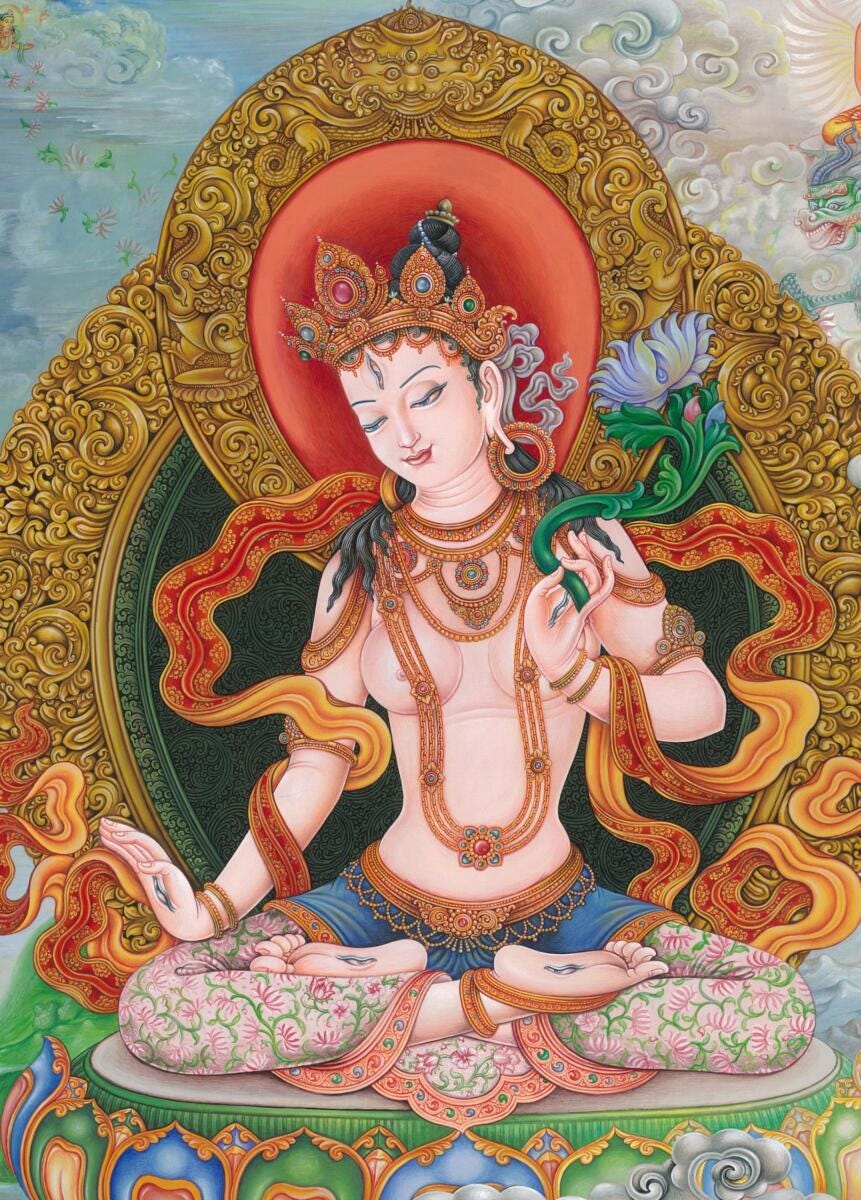
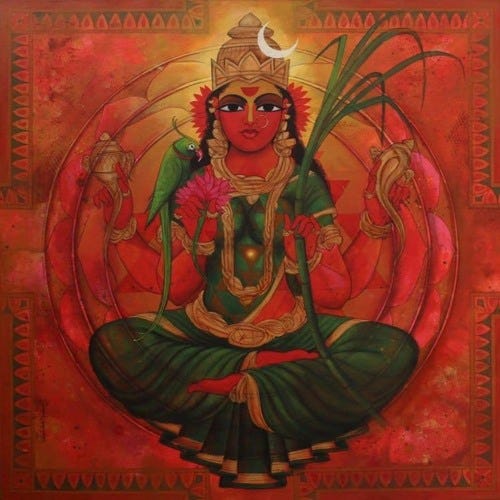

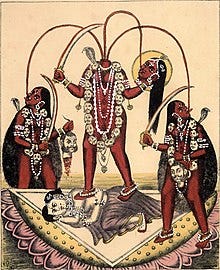

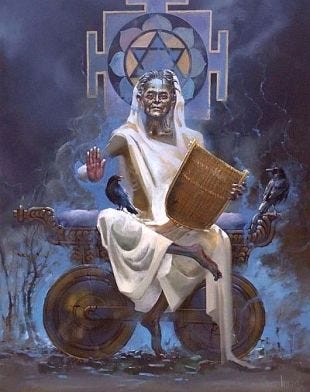



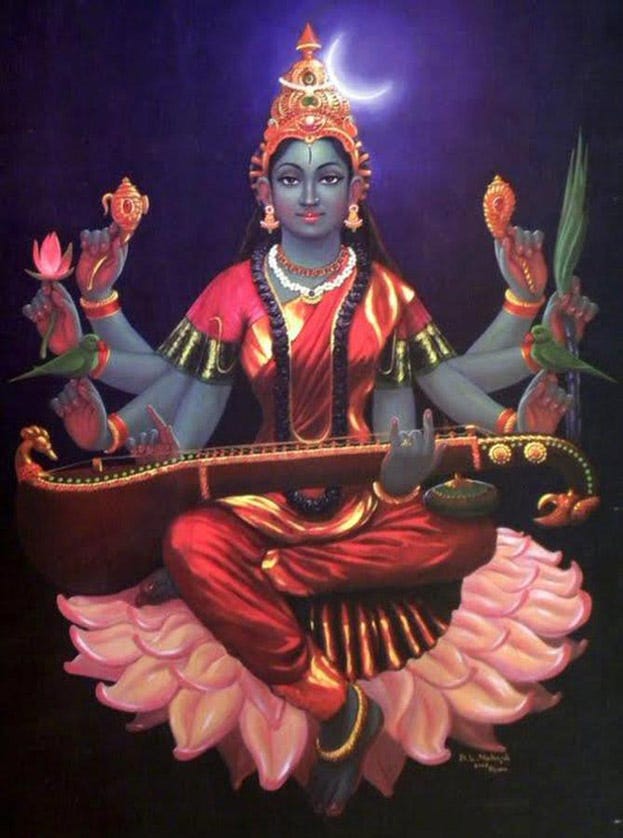
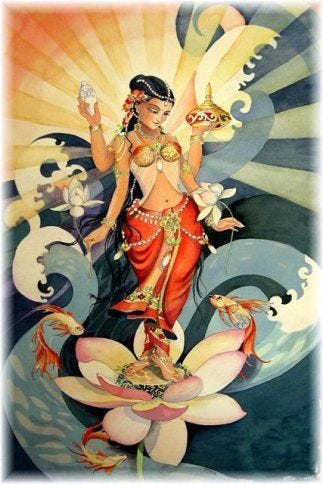
Thanks for this indepth look. I learned so much!